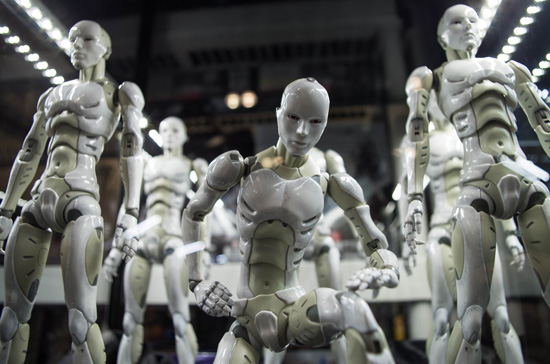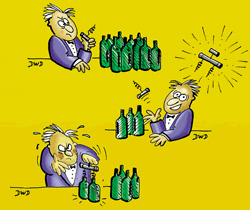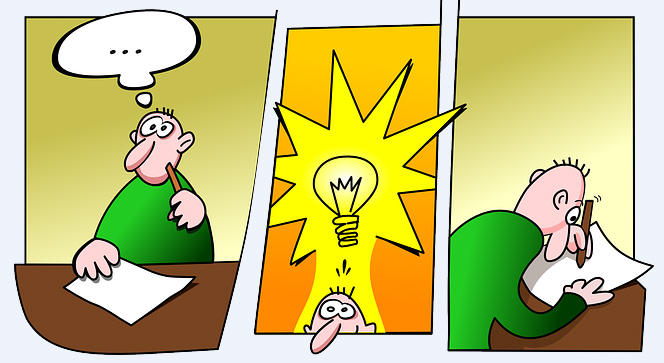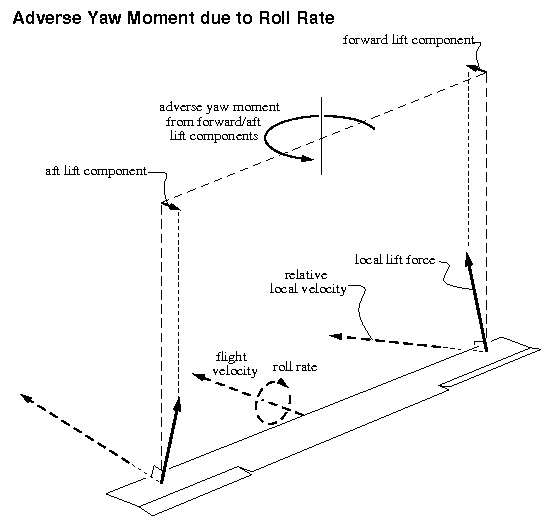
1. ‘You talkin’ to me?’; Source: Et-Zeichen

2. The inventor hasn't fully considered the problem; Source; Attribution
The EPO’s website contains a list of “Seven deadly sins of the inventor”, each of which I have seen made repeatedly. All inventors are encouraged to review this link from time to time. Of these seven “sins”, the one I would like to focus on today is “The inventor hasn't fully considered the problem” as humorously depicted in this cartoon (See Figure 2). While I don’t suggest that anyone would seriously “invent” a wine bottle opener like the one shown, not fully considering both the problem and any potential side effects caused by your solution can be just as big of a mistake.
To help explain, today I’m going to discuss three case studies on the treatment of side effects to an invention that include simply ignoring them, reacting to them, and anticipating them. I think you’ll see that every new problem uncovered is an opportunity not to be wasted.
Ignoring the Side Effects
I’m going to start with a real application I’m familiar with from years ago. All the details have been greatly changed for confidentiality’s sake, with only a sliver of the broadest concept kept alive to illustrate the point.
Imagine you are a salesperson that spends much time in various locations around the globe. As a very successful salesman you have a gigantic contact list in your phone. In fact, the list is so large that it makes it quite difficult to figure out which contact is in the location you are currently visiting. To solve this problem, you find a way to maintain a set of different contact lists, one list for each location. Just open the correct list for the location and the problem is solved, right?
Well, you still have the problem of finding the right list, which as we all know, is extremely inconvenient.
So you invent a contact list that taps into your phone’s location awareness services and only displays contacts that live in the geographical region where you happen to be, greatly simplifying your original problem.

3. Contact lists automatically selected by my location! I'm going to be so rich!; Source
Right about now, most inventors would rush to the patent office. But then a funny thing happens. While at the patent office in Silicon Valley, you have to call your patent attorney who happens to live in Taipei, but your phone doesn’t list her as a contact anymore because you are not in the same geographical area.
This is a side effect of your invention that you may not have considered. Not fully considering the problem including this undesirable side effect before hitting the patent office may have seriously degraded the value of the invention. Sometimes fixing the problem is trivial. Sometimes ignoring a relatively minor side effect can be a sound business decision. But not considering the side effect can open the door for somebody else.
Reacting to Side Effects that come Out of the Blue
When the Wright Brothers came up with the concept of wing-warping to control roll of an airplane, they thought they had solved the last remaining problem of controlled powered flight. They were deadly wrong. Wing-warping twists the wings of an airplane so that the leading edge of one wing points slightly downward while the leading edge of the other wing points slightly upward, imparting desired rotation around the longitudinal axis of the plane. Today we do this with ailerons.

4. Adverse yaw mechanism diagram; Source
To their utter astonishment and dismay, while it worked, occasionally this wing-warping also caused the plane to go into an uncontrolled horizontally spinning death spiral, once nearly killing Orville in the crash. The Wrights called this death spiral “well-digging” and its cause is better known today as “adverse yaw”. Because lift is basically perpendicular to the surface of the wing, when the wings point in opposite directions, as while wing-warping, components of the lift also point in opposite directions pulling the plane into a spin.
Sometimes the best laid plans can and will experience serious setbacks out of the blue. It’s Murphy’s law, but it is also an opportunity.
Confronted with the well-digging side effect which would make their wing-warping invention worthless by being too unsafe to use, even without correctly understanding the actual cause of well-digging, they came up with a solution to counter the side effect and that made them immortal and rich. Discovering a side effect and finding its solution can be a great way to perfect an invention and gain powerful claim limitations or even additional patents.
Anticipating the Side Effects
Presently, artificial intelligence has become the hottest, and incidentally best paying, area in computer related fields. Sure, there are robots that can make your double cheeseburger for you at some burger joint, but these are just expert systems programmed explicitly to perform one or more well defined tasks. After 50 years of unfulfilled promises of AI, the age of deep learning may be finally showing fruits of success. One sign of this was the much publicized victory of Google DeepMind’s AlphaGo program in the board game Go over Lee Sedol, one of the highest ranked players in the world.

5. Go had previously been regarded as a hard problem in machine learning that was expected to be out of reach for the technology of the time. Some experts thought that it would take at least another decade before computers would beat Go champions; Source
Deep learning is a neural network algorithm that basically learns by itself, based on experience, to model high level abstractions, meaning it can figure out how to deal with a new situation without requiring explicit training or directive coding; AlphaGo was not programmed to play Go, it learned to play Go.
Even at this level of AI, this technology promises to be perhaps one of the greatest game-changing inventions in history. Yet recently several high profile people such as Elon Musk and Stephen Hawking have warned us, not specifically against the Skynet scenario in the movie Terminator, but of the dangers of unintended side effects of this inventive form of AI. Musk, who is an investor in DeepMind and should know, said we’re “Summoning the Demon” with this kind of AI in part because one of the many side effects is that we may not be able to control it.
For example, when you want to take that burger flipping expert system offline because it is misbehaving or whatever, you can simply throw a switch and it stops. One potentially serious side effect of deep learning AI is that because the system constantly learns better ways to achieve its goals, the invention may learn how to ignore any attempt to shut it down – because that obviously would prevent it from achieving the goal. This could be disastrous especially when used in something that can be dangerous such as a weapon system or even a self-driving car.
One of the researchers at DeepMind recently published a paper discussing this exact “kill switch” issue. We don’t know if something happened at DeepMind or if the paper was just aimed at anticipating potential side effects to their inventions, but kudos are due them for working on solutions in advance to prevent this undesirable possibility.
Anticipating side effects of an invention can be a great way to avoid future problems, and that goes for all fields, not just AI. Samsung is a very fine company indeed, but I’ll bet this time they wish had considered possible unfortunate side effects of new batteries a little more.
Summary
Most inventions have side effects that may cause problems or offer opportunities. Sometimes an invention disrupts the economics of an industry in an interesting way. Maybe a new circuit generates extra heat that can be creatively harnessed. That new Internet-of-Things device may have unforeseen security concerns. Maybe just sorting the full contact list by location works best. Fully considering side effects to an inventive solution is more than just smart; it may offer opportunities worth more than the original invention.
[Views expressed in in this article are exclusively those of the author and do not necessarily reflect views of NAIP or any of its affiliates.]
 |
|
| Author: |
Daniel Gross |
| Current Post: |
Senior Engineer, Quality Control Manager, NAIP |
| Education: |
BS Computer Science and Engineering, University of Nebraska
Graduate work in the Human Computer Interface |
|
|
|
| Facebook |
|
Follow the IP Observer on our FB Page |
|
|
|
|
|
|

